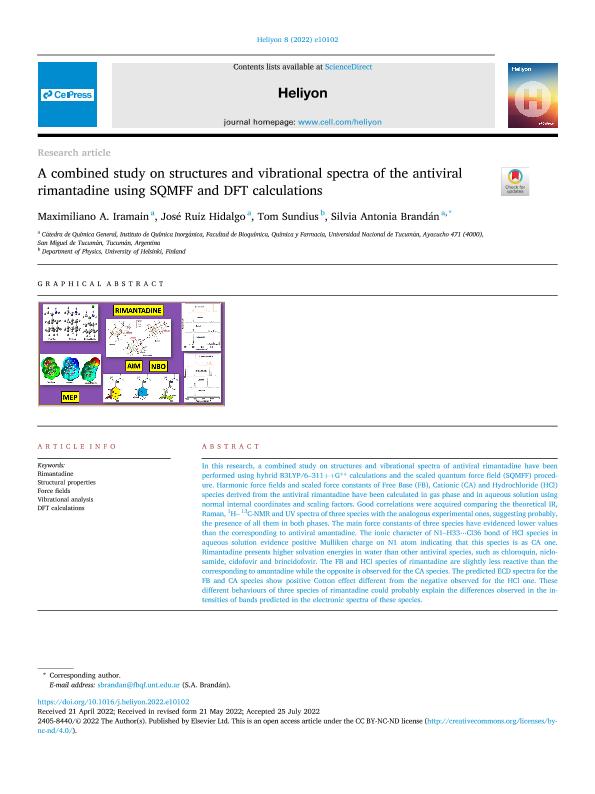Mostrar el registro sencillo del ítem
dc.contributor.author
Iramain, Maximiliano Alberto

dc.contributor.author
Ruiz Hidalgo, José

dc.contributor.author
Sundius, Tom
dc.contributor.author
Brandan, Silvia Antonia

dc.date.available
2023-12-19T11:39:31Z
dc.date.issued
2022-08
dc.identifier.citation
Iramain, Maximiliano Alberto; Ruiz Hidalgo, José; Sundius, Tom; Brandan, Silvia Antonia; A combined study on structures and vibrational spectra of the antiviral rimantadine using SQMFF and DFT calculations; Elsevier; Heliyon; 8; 8; 8-2022; 1-14
dc.identifier.issn
2405-8440
dc.identifier.uri
http://hdl.handle.net/11336/220735
dc.description.abstract
In this research, a combined study on structures and vibrational spectra of antiviral rimantadine have been performed using hybrid B3LYP/6–311++G∗∗ calculations and the scaled quantum force field (SQMFF) procedure. Harmonic force fields and scaled force constants of Free Base (FB), Cationic (CA) and Hydrochloride (HCl) species derived from the antiviral rimantadine have been calculated in gas phase and in aqueous solution using normal internal coordinates and scaling factors. Good correlations were acquired comparing the theoretical IR, Raman, 1H– 13C-NMR and UV spectra of three species with the analogous experimental ones, suggesting probably, the presence of all them in both phases. The main force constants of three species have evidenced lower values than the corresponding to antiviral amantadine. The ionic character of N1–H33⋯Cl36 bond of HCl species in aqueous solution evidence positive Mulliken charge on N1 atom indicating that this species is as CA one. Rimantadine presents higher solvation energies in water than other antiviral species, such as chloroquin, niclosamide, cidofovir and brincidofovir. The FB and HCl species of rimantadine are slightly less reactive than the corresponding to amantadine while the opposite is observed for the CA species. The predicted ECD spectra for the FB and CA species show positive Cotton effect different from the negative observed for the HCl one. These different behaviours of three species of rimantadine could probably explain the differences observed in the intensities of bands predicted in the electronic spectra of these species.
dc.format
application/pdf
dc.language.iso
eng
dc.publisher
Elsevier

dc.rights
info:eu-repo/semantics/openAccess
dc.rights.uri
https://creativecommons.org/licenses/by-nc-nd/2.5/ar/
dc.subject
DFT CALCULATIONS
dc.subject
FORCE FIELDS
dc.subject
RIMANTADINE
dc.subject
STRUCTURAL PROPERTIES
dc.subject
VIBRATIONAL ANALYSIS
dc.subject.classification
Otras Ciencias Químicas

dc.subject.classification
Ciencias Químicas

dc.subject.classification
CIENCIAS NATURALES Y EXACTAS

dc.title
A combined study on structures and vibrational spectra of the antiviral rimantadine using SQMFF and DFT calculations
dc.type
info:eu-repo/semantics/article
dc.type
info:ar-repo/semantics/artículo
dc.type
info:eu-repo/semantics/publishedVersion
dc.date.updated
2023-12-18T12:08:08Z
dc.journal.volume
8
dc.journal.number
8
dc.journal.pagination
1-14
dc.journal.pais
Estados Unidos

dc.description.fil
Fil: Iramain, Maximiliano Alberto. Universidad Nacional de Tucuman. Facultad de Bioquimica, Quimica y Farmacia. Instituto de Quimica Inorganica. Cátedra de Química General.; Argentina. Consejo Nacional de Investigaciones Científicas y Técnicas. Centro Científico Tecnológico Conicet - Tucumán; Argentina
dc.description.fil
Fil: Ruiz Hidalgo, José. Universidad Nacional de Tucuman. Facultad de Bioquimica, Quimica y Farmacia. Instituto de Quimica Inorganica. Cátedra de Química General.; Argentina. Consejo Nacional de Investigaciones Científicas y Técnicas. Centro Científico Tecnológico Conicet - Tucumán; Argentina
dc.description.fil
Fil: Sundius, Tom. University of Helsinki; Finlandia
dc.description.fil
Fil: Brandan, Silvia Antonia. Universidad Nacional de Tucuman. Facultad de Bioquimica, Quimica y Farmacia. Instituto de Quimica Inorganica. Cátedra de Química General.; Argentina
dc.journal.title
Heliyon
dc.relation.alternativeid
info:eu-repo/semantics/altIdentifier/url/https://linkinghub.elsevier.com/retrieve/pii/S2405844022013901
dc.relation.alternativeid
info:eu-repo/semantics/altIdentifier/doi/http://dx.doi.org/10.1016/j.heliyon.2022.e10102
Archivos asociados
